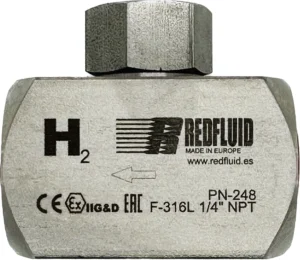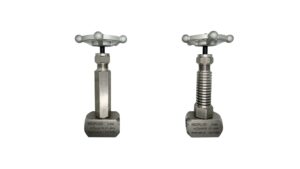
Hydrogen Check Valves
Imagine installing just any check valve in a hydrogen circuit. At first, everything seems to work fine — but over time, internal materials begin to
Valves are considered instrumentation and control elements that are normally used to control the flow of a fluid within a system. But.. what are the differences between ball and needle valve?
While there are many different types of valves in the market, it is difficult to argue that ball valves and needle valves are among the most common ones.
When it comes to a ball valve and a needle valve, the main differences are found in the design and the main use they have. To better understand the differences, let’s take a closer look at each one of them.
The main characteristic of a ball valve is that it is designed with a flow control element in the shape of a ball. However, the ball is not completely solid since it features a channel through its center to allow the pass of the fluid when it is open.
To switch a ball valve from open to close and vice versa, only a quarter of a turn (90 degrees) is required. Therefore, it is easy to identify whether the ball valve is open or close by looking at the position of the handle. When the handle is parallel to the pipe, the ball valve is open, and when it is pointing across the pipe or valve body, the ball valve is closed.
Ball valves are usually found as full-bore valves although they can also be acquired with reduced bore upon request.
Other important characteristics of ball valves are:
As it happens with the ball valve, the most distinctive feature of a needle valve is the element for flow control. Instead of a ball, a needle valve has a plunger in the shape of a needle, hence the name. To control the position of the needle-shaped plunger, there is a threaded rotating stem mechanism, which makes the control very precise.
While adjusting how open or close a needle valve is can be very accurate, it becomes difficult to quickly switch from fully open to fully closed and vice versa since it usually requires between 5 to 6 full turns to achieve it.
Needle valves can be used in high-pressure applications with some of them being capable of handling up to 10000 psi (700 bar).
Other relevant features of a needle valve include:
Taking from the descriptions above, the differences can be very obvious. Clearly, the main difference is in the design of the element for flow control. Nevertheless, let’s summarize them as follows:
At this point, you may already know what is the difference between a ball valve and a needle valve. Using that knowledge and the requirements of the application you have in hand, it should not be very difficult to decide whether a ball valve or a needle valve is the best option for you.
For example, if your intention is controlling when fluid should be moving through a pipeline at high flow rates, then a ball valve would be your go-to alternative. However, if what you need is adjusting the flow rate to a very accurate value, then a needle valve will suit you best.
Also, remember that you need to consider other aspects regarding the requirements of your application, including but not limited to:
Of course, there may be situations when the best option is difficult to identify. So, whenever in doubt, the recommendation is to contact the experts in the field.
If you are having trouble finding the best valve for your specific application, or you would like more about the different valves we have in stock, do not hesitate to contact us and we will be more than happy to help you.
Share this post

Imagine installing just any check valve in a hydrogen circuit. At first, everything seems to work fine — but over time, internal materials begin to

You’ve probably heard about high-temperature or cryogenic valves, the ones that are incredibly resistant because they operate under extreme conditions. But what makes them so
This website uses cookies so that we can provide you with the best user experience possible. Cookie information is stored in your browser and performs functions such as recognising you when you return to our website and helping our team to understand which sections of the website you find most interesting and useful.
Strictly Necessary Cookie should be enabled at all times so that we can save your preferences for cookie settings.
If you disable this cookie, we will not be able to save your preferences. This means that every time you visit this website you will need to enable or disable cookies again.
Esta web utiliza Google Analytics para recopilar información anónima tal como el número de visitantes del sitio, o las páginas más populares.
Dejar esta cookie activa nos permite mejorar nuestra web.
Please enable Strictly Necessary Cookies first so that we can save your preferences!
2 Responses